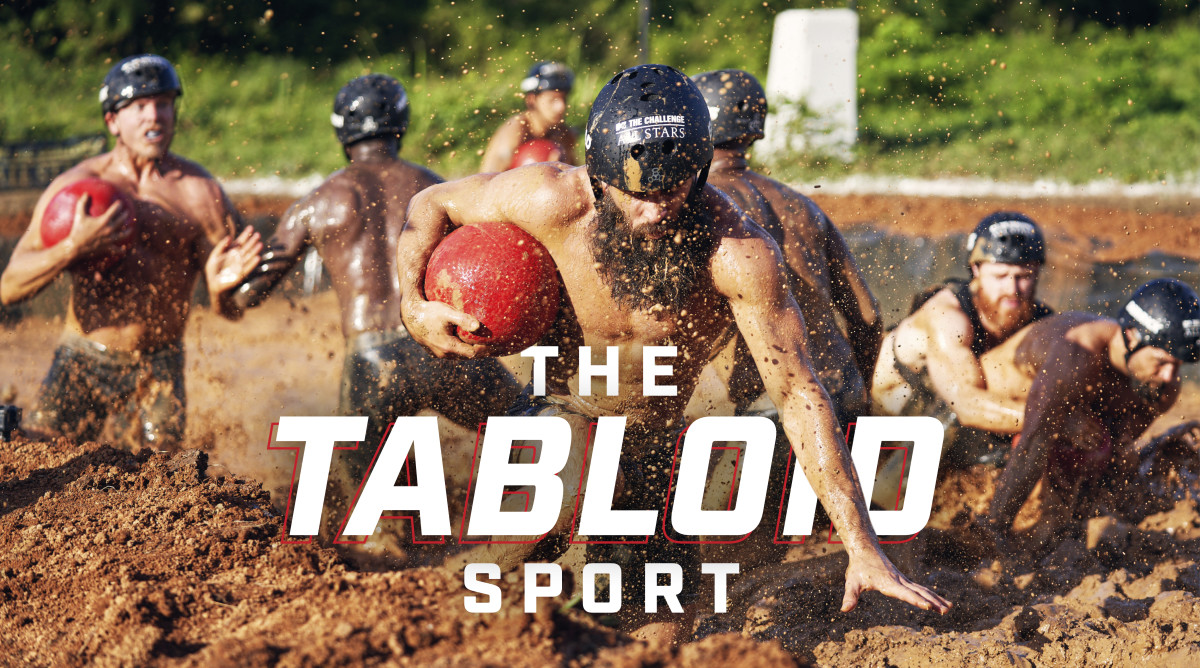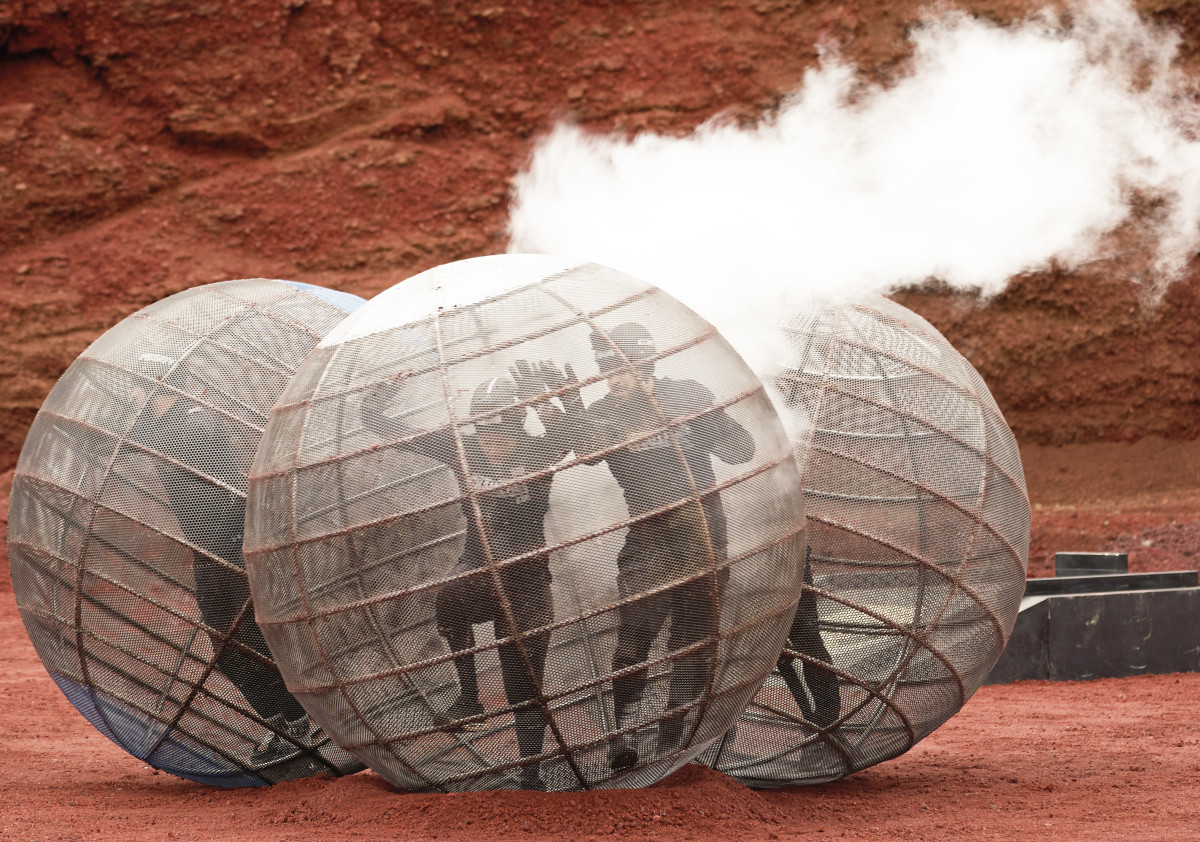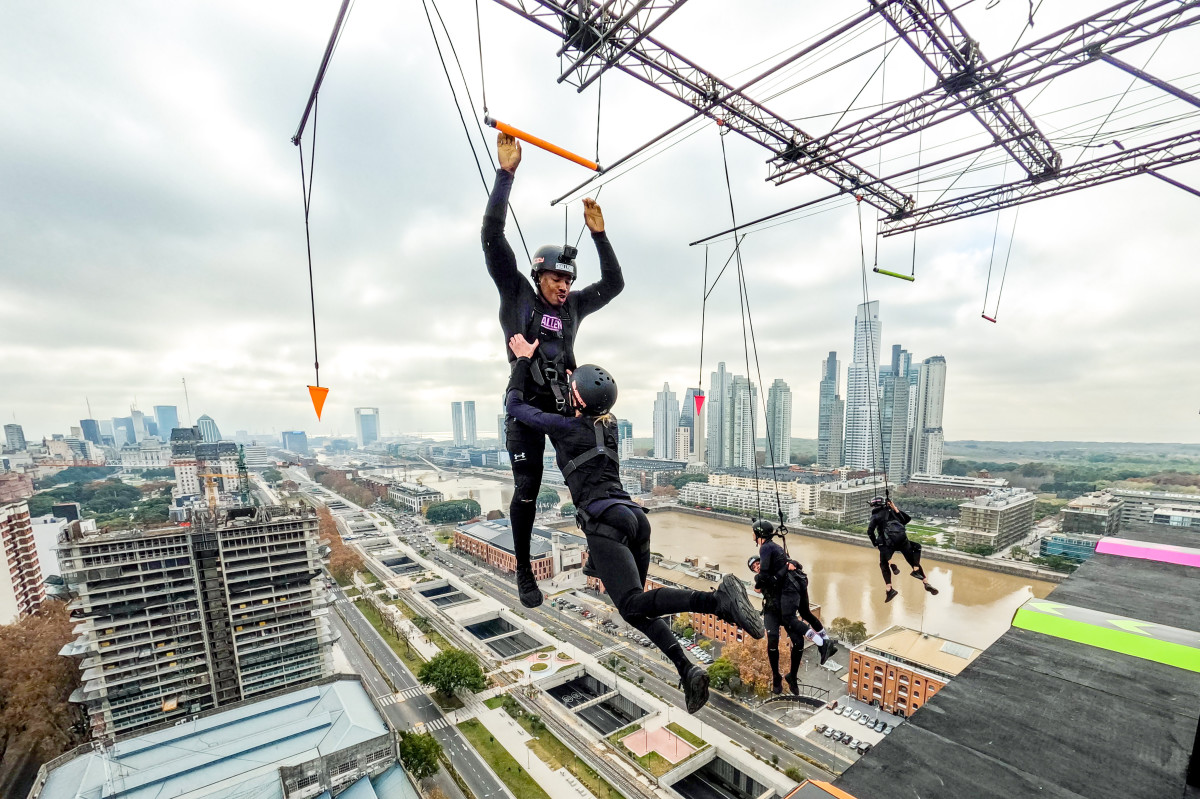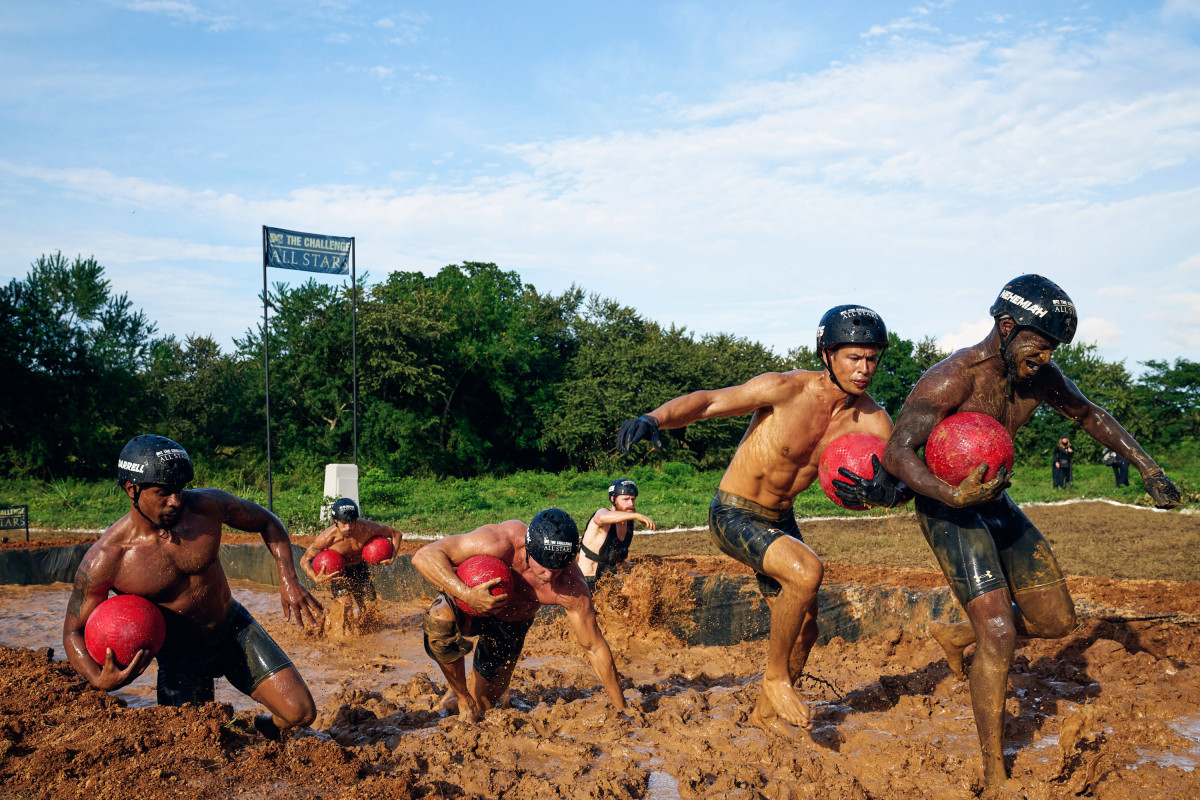How MTV’s ‘The Challenge’ Became the Reality Show for Sports Fans

T.J. Lavin, the host of MTV’s The Challenge, could only cackle as a tank he’d commandeered ran amok, drawing looks of anguish from those around him. Everyone aside from Lavin had been tasked with dragging heavy cargo across a 500-foot field, stopping only to solve a jigsaw puzzle and math equation. If Lavin caught up to the contestant and flattened their supplies, they were eliminated. It was a grisly yet welcome sight for those who watched the premiere of the 35th season of MTV’s The Challenge, which aired April 1, 2020, weeks after the beginning of the COVID-19 pandemic, and was fittingly filmed in and around an isolated Cold War bunker in Prague months before “social distancing” entered the lexicon.
For a few months at the outset of the COVID-19 pandemic, nearly every sports league around the world halted operations. That left sports fans starving for athletic content—you could only watch The Last Dance and reruns of classic games so many times.
In the peculiar early-pandemic era, the reality competition show in its fourth decade of existence qualified as the newest physical competition available to broadcast on television. And it filled that void quite successfully, premiering to its biggest audience for a season premiere in nearly 15 years.
“It was such ridiculous timing that we aired when we did, when the country went into an awful lull,” executive producer Emer Harkin told Entertainment Weekly at the time. “For us to be the competition sporting outlet that everybody so desperately needed, it also bolsters our case for the importance that our show plays and our massive audience in the States.”
Viewers in sore need of something to take their minds off the dystopian scenario enveloping the world tuned in to see fan favorites like Johnny “Bananas” Devenanzio and Ashley “Millionaire” Mitchell start the long, grueling journey of competing for a $1 million prize. And that journey began with the sort of brutal yet lighthearted competition the show has held for nearly a quarter-century.

The winners of that opening challenge—after much social politicking, revisiting of old grudges and, yes, even an opening-night hookup—then nominated competitors into an elimination challenge. The winner stayed, the loser went home. Confessional-style interviews were cut between it all, delivering sound bites like, “I would die for that money. I would kill for that money. I would screw over anyone for that money.” It’s a pretty typical formula these days, but it’s one The Challenge helped to pioneer all the way back in 1998 and has tweaked over the years to keep things fresh.
After the premiere episode’s ratings saw its biggest lift among men ages 18–49 (up 71% from the previous season average) and men ages 18–34 (up 69%)—indicating a sharp increase in interest from what’s traditionally thought to be the typical sports fan—the finale ranked as the No. 1 cable show among the aforementioned demographics.
While the show got a ratings boost from filling 2020’s sporting vacuum, it’s long been hitting the same sort of rooting interests that attract fans to sports—yes, physical feats, but also character arcs featuring struggles, betrayals, vendettas, redemption, romance and growth. Because even if they don’t like to admit it, most sports fans voraciously consume and discuss the off-field drama that tends to envelope athletics and is usually left to insiders to relay to the public. The Challenge delivers juicy story lines in spades, plus entertaining physical competitions, all on its own.
“It’s almost like watching your favorite sports team, but then knowing what goes on in the locker room,” says executive producer Dan Caster. “It’s like a tabloid sports event.”
There’s clearly a demand for physical competition mixed with exaggerated personal drama. There are 37 seasons of the original series in the books, with the 38th season having premiered Wednesday, and multiple spin-offs, including The Challenge: All Stars on Paramount+, the third season of which aired this summer, and The Challenge: USA, which just finished its first season last month and marked the franchise’s debut on CBS. The Challenge has even outlasted the MTV franchises that originally comprised the casting pool, Real World and Road Rules, and has expanded to pull contestants from more than 27 outside franchises around the globe, including Survivor, Big Brother, Love Island and The Amazing Race. The last season aired in more than 190 countries with 17 international competitors representing 10 different countries (including the U.S.). An episode’s run time spans 90 minutes, a rarity across television programming that shows viewers’ patience and hunger for as much Challenge content as possible.
The show’s success reflects the way that celebrity culture has fully bled into sports. Perhaps The Challenge has influenced the way conventional sports are covered and marketed, too. Fans now often root for (or jeer against) individual athletes rather than teams and follow stars’ personal lives through both around-the-clock conventional media coverage and social media. And it sure seems like more modern athletes are willing to engage in petty, reality-TV-esque feuds, no matter the fallout (looking at you, Joel Embiid—even though Giannis Antetokounmpo is perhaps the sports world’s most famous Challenge fan).
But the truth is that as some sports coverage has started to resemble tabloid entertainment, The Challenge has gone in the opposite direction and matured from its silly, lowbrow roots into a punishing marathon of a competition.

Don’t feel guilty if you find yourself flipping through Us Weekly in the grocery checkout line. Humans have been trained to have our interest piqued by gossip. It was a critical part of our evolution.
When our ancestors lived in small groups and came upon strangers, exchanging information about others served a useful social function that helped us not only bond, but survive. We’re not alone in this; other primates gossip about those close to them as well as high-status individuals … or celebrities.
Even if we don’t personally know someone, there can be social value in knowing what’s happening in their lives. MTV probably knew that when it decided in 1992 to develop a show created by Mary-Ellis Bunim and Jonathan Murray in which seven strangers lived together for several months, had their lives taped and found out what happens “when people stop being polite and start getting real.”
That was the premise of The Real World, the revolutionary program that ran for 33 seasons until 2019, sparking the reality TV craze and spawning The Challenge along the way. Real World castmates were plucked from a wide variety of backgrounds, which often led to the sort of conversations, friendships, romances and fights that many viewers had never seen before—on or off television. Naturally, that made the show a hit, and often transformed its cast members into celebrities.
“After I watched a few episodes, I’m like, wait a minute, I’ve gotta get this straight,” says Devenanzio, who appeared on 2006’s Key West season. “These guys are famous, and they're gaining notoriety from going out and partying and just being themselves? I was like, I can do that.”
Near the end of the 1990s, with a casting pool filled to the brim with engaging personalities who’d created their own subset of fame, MTV looked to capitalize on The Real World’s success by spinning off a competition show featuring its contestants (as well as some castmates from Road Rules, which debuted in ’95 and had essentially the same premise except everyone lived in an RV). The Challenge maintained the socially edgy aspects of its parent shows while infusing a competitive aspect, hoping to combine the built-in viewership of its flagship reality programs with a new audience drawn to athletics.
The early days of the show, at different times called Road Rules: All Stars and Real World/Road Rules Challenge, hardly featured world-class athletic feats, though.

“Worms in your mouth? Dried chicken feed in your mouth and regurgitating it in a [fake] bird’s mouth? That is wrong. … Who does that?” says Holly Shand, a contestant on 2004’s The Inferno who was soon to be dressed in a chicken suit, racing to do just what she described.
That’s just one memorable example of the simple, frivolous games that populated the early years of the show. What’s become a high-budget production featuring helicopter stunts and explosive set pieces you’d expect from a Michael Bay movie had much more modest beginnings. Other highlights included teams racing to melt a giant ice cube by rubbing their bodies on it and consuming as much milk and cookies as possible until they … tossed their cookies. While you certainly had to be fit to go all the way and win the grand prize, many of the competitions weren’t particularly physically demanding and carried the aura of carnival games. The emphasis was more on carefree fun, and that ethos somewhat extended to the entire process, which was much less buttoned-up than it is today.
“It was just like summer camp,” says Aneesa Ferreira, who debuted on the sixth season in 2002 and has gone on to participate in 19 seasons across the Challenge universe. “We never had a gym! In my first season, we were in Jamaica in a resort with two villas. We swam at the boys’ pool, and we laid out [when not competing].”
“[The producers] would be like, ‘Run around the backyard if you want to stay in shape. Or lift lawn furniture,’” says Devenanzio, who debuted on the 13th season in 2006 and has competed in 22 seasons.
One of the biggest catalysts in changing the show’s laid-back approach is showrunner Justin Booth, who joined the production team as a segment producer in Season 7 and was promoted to executive producer by season 10. A middle-aged Navy veteran with a thick Southern accent, Booth is not the type of guy you’d imagine to be helming an MTV reality show. But he turned out to be exactly the sort of figure The Challenge needed to usher in a new era.
After previously working in the late 1990s on an MTV stunt show called Senseless Acts of Video, Booth saw the potential to raise the stakes.
“It didn’t take me long to feel like I wanted to push the envelope a little because the game seemed a little campy to me,” he says. “I was like, there’s so much more that we could be doing. And I was fresh off of a stunt show, so I had that mentality at the time. … I wanted to take away the ‘chicken soup’ factor and make it more of a game than a summer camp kind of thing.”
Booth also figured that putting the contestants through the ringer in every possible way would heighten the “off-field” story lines, too. He tightened up restrictions for cast members around the house they live in for several months over the duration of filming, banning cellphones, internet access, television, music and even books. The decision was also made at some point to limit alcohol consumption after contestants previously had 24/7 open bar access (perhaps after one too many regrettable booze-fueled incidents, even for a reality show). Phone calls with family members are now limited to roughly twice per week, with special cases for medical circumstances and emergencies.
“It sounds crazy, but we say it all the time: We feel like we’re prisoners when we’re there—and we continue to say, well, it’s the nicest prison that ever existed,” says Veronica Portillo, a 13-time participant and three-time champion who debuted on the third season in 2000. “I don’t want to sound like I’m not grateful, but when you’re at the airport and hand over your phone, medicines, supplements, everything except your clothes and shoes … the whole experience is very hard mentally.”
“You discover a lot about yourself when you’re in the worst situations,” Booth says. “The idea was to kind of emulate that a bit, because we wanted to see what these kids would discover about themselves. Because at the end of the day, it’s still a storytelling adventure that we’re involved in. We wanna learn and get to know these guys and find out about them as they find out about themselves.”
What Booth has witnessed over the years has impressed him far beyond what he expected from a bunch of reality TV stars, most of whom have adapted to the more adverse conditions.
“As the show evolved, I think [the producers] realized, the more we make them focus on the game, the more we isolate them, the less outlets they have, the more they’re forced to live and breathe The Challenge, 24 hours a day, seven days a week,” Devenanzio says. “It’s a very mentally and emotionally draining experience now.”
Even if the going is a little tougher now, for most, it beats finding a regular job. Still, what was once a vacation is now treated like a business trip. Each passing season seems to feature less sleazy drama and more training montages set to music from MTV’s extensive catalog. “This was my dream job when I was 15 years old,” Turabi “Turbo” Çamkıran said in a confessional after becoming the first international player to be crowned the winner of a season. “And now I’ve won my dream job.”
There’s certainly much more worth working toward now. Whereas the grand prize for the first season was a trip for two to Costa Rica, there’s now a total of $1 million distributed between the show’s winners and, occasionally, finishers lower on the podium. Even though every contestant is paid for their time on the show, the appeal of a life-changing amount of money at the end of the tunnel has instituted a cutthroat nature to the game.
“We’ve gone from summer camp to boot camp,” Devenanzio says. “Then, it’s off to war.”
The equivalent of “war” in the Challenge universe is the final, as the most taxing element of the show is saved for last. What was once a mildly difficult race over the course of a few hours is now an overnight, multi-legged (and sometimes multi-episode) affair that often involves sleep deprivation, extreme temperatures and, above all, physical and mental endurance. It’s the ultimate embodiment of the show’s improvisational athletics, as the contestants never know exactly what’s in store, only that it will leave them utterly exhausted. Many competitors have also been felled by fairly basic math problems, which is always good for a laugh.
The complete package of an elite Challenger encompasses not only physical prowess, but also quick wits and the social skills to ingratiate oneself within the messy power dynamics that are always shifting. And if you want to become a recurring cast member, the audience has to connect with your personality, whether it’s as a lovable hero, lively narrator, complex antihero or dastardly villain.
“You need to be well-rounded and relatable,” Ferreira says. “So like, you can win a daily [challenge] and also win the hearts of America.”
“The people most important to the show aren’t the ones who are competing best,” Devenanzio says. “It’s the ones giving the best interview bites. Because without that, you don’t have a show.”
In the end, though, the winners have to cross a certain threshold of physical endurance because that aspect is thoroughly tested in the final event.
Multiple people involved with The Challenge single out the finale from 2019’s War of the Worlds as the toughest test in the show’s history. Staged in the Namibian desert, a 50-mile “death path” had contestants run and bike through the sandy terrain, stopping at several checkpoints to complete puzzles, play backyard-style games or answer trivia questions. They stayed overnight in a rusted, smelly, cramped container dubbed “the pain locker.” One contestant voluntarily withdrew. Another was medically removed after collapsing multiple times due to heat exhaustion. Another passed out for a few minutes and somehow continued. Another underwent what he described as a “full body cramp” and keeled over, eventually succumbing to the pain. Even the winner, who was cast after winning two seasons of the Turkish version of Survivor, had to push through a leg injury that temporarily had him writhing on the ground in pain. The producers elected to allow everyone who finished the first leg to take IV fluids that night.
“On the day before, I was like, Dude, this is impossible. There’s no way they’re gonna do this,” says Lavin, who often test-runs the finals (and runs a 5K every day to stay in shape to do so). “I asked [Booth], ‘Are we really making them do this? We’re gonna kill them.’ He was like, ‘It’s for a million dollars; let’s do this.’”

As the universally beloved host of the show for 27 seasons and counting, it might strike you as a bit odd we’re just now getting to Lavin’s impact on the show. But perhaps it’s fitting. The 45-year-old isn’t the face of the show, as, say, Jeff Probst is for Survivor. He doesn’t narrate the competitions, which instead falls to the castmates via confessionals. (“Maybe that’s why I’ve never gotten an Emmy—I’ve gotta start narrating,” Lavin jokes.) He’s also content to take a back seat from a production standpoint and let the showbiz people do what they do.
“If it ain’t broke, don’t fix it,” Lavin says. “Everyone has their role. I don’t want to disrupt anything. I just stay in my lane. No reason for me to press this or press that.”
Alternatively described by a pair of contestants in his first scene as “one of the greatest dirt jumpers to ever walk the face of the earth” and a “sexy, sexy, stud,” the 10-time X Games medalist has grown to serve as an on-screen mentor of sorts rather than just the cool friend, now more like the helpful yet stern older brother. He told the contestant who withdrew from the War of the Worlds final, “You know, you’re a really good competitor. You just have to stop smoking f----ing cigarettes.”
While a smoker could have harbored realistic hopes of winning a final in the show’s early years, that’s no longer the case. Casts for the main show have come to include a three-time Olympian in Lolo Jones and many former collegiate athletes who didn’t appear to have lost a step from their playing days. There have also been three spin-off seasons that pitted Challenge legends against teams of professional athletes or athletically inclined celebrities including Jones, Olympic medalists Shawn Johnson, Gus Kenworthy and Lindsey Jacobellis, former NFL stars Terrell Owens and Arian Foster, ex-NBA player Daniel Gibson, MMA fighters, WNBA players and more. Challengers won all three times.
“We’ve been having these athlete types coming in more, and some of these kids can’t do s---, you know?” says Darrell Taylor, a 13-time participant who debuted in 2004 and won the Champs vs. Pros spin-off in addition to four editions of the main show. “They’re good physically, but mentally, they crumble. Not all of them, but … just saying.”
A key figure in increasing the show’s visibility in the sports landscape has been Bill Simmons, the former ESPN writer and CEO of The Ringer, who dubbed the competition “America’s fifth major sport” and started covering it on his popular podcast in the late 2000s. The Ringer now hosts a podcast by Devenanzio, who, as a seven-time champion, is the closest thing the show has to Tom Brady. Simmons got Bananas on board by pitching his role as the equivalent of Tony Romo in the broadcast booth.
“When Bill Simmons started talking about it, that was the first time I was like, ‘What are they doing talking about all this stuff?’” Booth says. “That was the first time I noticed that there had been some progress, if you will, to that demo.”
Buoyed by a growing and diverse viewership, a ballooning budget has helped institute a cinematic, action-movie-like quality to the increasingly epic competitions, which often feature helicopters, speed boats and pyrotechnics that seem like they’re operated by Danny McBride’s character from Tropic Thunder.
“This truly is a soap opera competition show,” Caster says. “Our goal is always to make it feel like a movie.”
At its core, though, The Challenge is, ironically, a show built around its cast rather than its challenges. Many seasons bring back roughly half of the previous edition’s participants, renewing old rivalries while letting in just enough fresh blood to act as underdogs and upset the apple cart.
“Something that’s really unique to The Challenge is that it has these long-running dramatic threads that you wouldn't necessarily expect from a reality TV show,” says Entertainment Weekly editor Sydney Bucksbaum, who has an upcoming book about the show titled How to Win at The Challenge and Life. “We’ve seen people grow up and change and mature and fall in love, get married, have kids, get divorced. You really form these parasocial relationships with these players that even on scripted shows you don’t get because they’re characters, whereas these are real people.”
The end product is a compelling battle between people who started as reality TV stars but have morphed into figures far more worthy of our attention—and brought an entire television genre with them.
“The Challenge has shaped the reality competition genre from the ground up,” Bucksbaum says. “When people think of reality competition shows, they may think of Survivor and Big Brother and all of these other shows. But I think it really comes down to the fact that those are on bigger networks with a broader reach. And The Challenge came first. But with MTV, the audience just being younger and not taken as seriously, that’s why The Challenge isn’t always given the reputation that it deserves.”
That may change in time, as the CBS-aired spin-off—which exclusively featured contestants from that network’s reality shows—further increased the franchise’s visibility and raised the possibilities of more crossover programs. There’s even a global championship of sorts set to debut next year where top competitors from the show’s different editions across the world will compete.
The flagship show’s castmates don’t seem to concern themselves with the show’s underrated legacy, though. They just relish the opportunity to live out so many people’s dream scenario of making a living on athletic competition. Even if it’s not the type most kids aspire to, or can even truly practice for, it’s not one many fans would turn down.
“The Challenge, to me, was like my sports team that I never got to play on as a child,” Portillo says. “Which makes it fun, because by the time we get into it, it’s the time when most people in athletics have to give up their dreams. And that’s right when we’re just getting started.”
Even when the show’s core castmates eventually age out, as all athletes do, they can take pride in building something that’s on pace to outlast them all.
• NBA Top 100 Rankings: And the Best Player Is ...
• Inside Aaron Judge's Pursuit of Home Run History
• The Trackhouse Revolution
